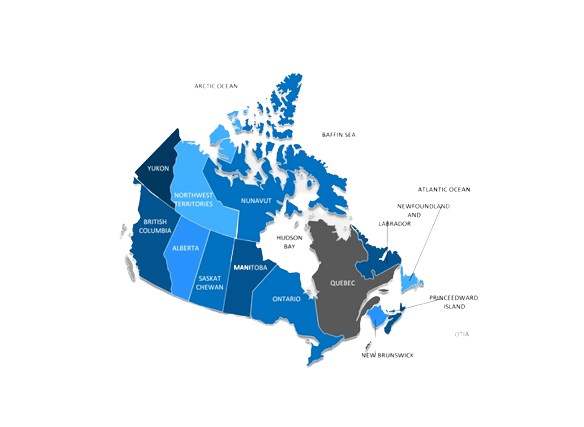
Canada
Canada is one of the most preferred educational destinations by students all around the world. But before deciding to choose Canada, you need to be aware about different aspects of Canada.
Geography
Canada's geography is incredibly diverse, offering a wide range of natural environments and ecosystems.
Canada boasts numerous lakes, including the Great Lakes (Superior, Michigan, Huron, Erie, and Ontario), which form part of the border between Canada and the United States.
Coastal regions tend to have milder temperatures due to the moderating influence of the ocean, while interior regions experience more extreme temperature variations..
Canada's land is richly varied, showcasing a diverse topography including mountains, lakes, streams, waterfalls, and more.

Why Study In Canada?
Studying in Canada offers numerous advantages, including high-quality education, diverse cultural experiences, excellent research opportunities such as
Studying in Canada offers numerous advantages, including high-quality education, diverse cultural experiences, excellent research opportunities as
Educational structure
Canadian universities and colleges consistently rank among the top institutions globally for their high academic standard and innovative teaching mathods.
Also, Canada is promising and offers numerous opportunities for personal, academic, and professional growth.
Apart from this, A Canadian education is recognized and respected worldwide, providing students with a strong foundation for their future careers.
- Student must have valid test result of IELTS or TOEFL with score of 6 or higher in each module completed within 2 years of the date of SDS application.
- Student need to submit a proof of guaranteed investment certificate (GIC) of 10,000 to 20,000 CAD in a bank insured by Canadian Deposit Insurance Corporation (CDIC).
- Students must pay the full annual tuition fee upfront to the university.
- Student have to submit recent academic transcripts, including post-secondary records.
- Student need to submit provide evidence of a mandatory upfront medical examination.
Admission Procedure
First milestone in the path of becoming an international student is getting admission in a DLI approved Canadian university/college. This process is majorly divided into four steps:
Choosing where to study and what to study are significant decisions that require careful consideration. It's essential to reflect on your interests and future career goals. Start by asking yourself key questions such as the field of study you're interested in and the job role you envision after completing your studies. Once you've clarified these aspects, you can begin researching colleges or universities offering relevant courses. Resources like the website or platforms like HARIKRUSHNA OVERSEAS can provide valuable information about educational institutions and available programs across different provinces. It's crucial to conduct thorough research into the curriculum of your chosen program to ensure it aligns with your goals. If needed, seek guidance from counselors who can assist you in finding the perfect fit for your academic and career aspirations.
Students should create a checklist of required documents to collect from their current or previous educational institution. Additionally,they must provide evidence of their performance in an internationally recognized English language proficiency test, such as IELTS,TOEFL, CEAL, PTE, or Duolingo.
Canada, there are three admission periods: winter, spring, and fall. It's advisable for students to apply 3-6 months before their chosen intake to allow sufficient time for the visa application process. Applications can be made directly through the university or college website, or students can opt to visit our office for assistance in submitting their applications and obtaining offer letters from well-regarded institutions.
After receiving an offer letter from the college, students must confirm their acceptance and reserve their seat by paying either the deposit fee or the first semester's tuition fee. Following the payment of the college or university fees, the next step is to deposit the required funds for the Guaranteed Investment Certificate (GIC) to fulfill visa application requirements.

Visa Requirements
- You all need an acceptance letter(LOA) from a designated Canadian educational institution.
- Demonstrate you have enough money to cover tuition fees, living expenses, and return transportation.
- Ensure your passport is valid for the duration of your stay in Canada.
- Depending on your country of residence, a medical exam may be required to prove good health.
- Provide a police certificate to show you have no criminal record.
- Depending on the program, prove proficiency in English with tests like IELTS, TOEFL.
- Provide biometric information (fingerprints, photograph).
- Some provinces require purchasing a GIC to cover living expenses.
- Submit a statement of purpose outlining study plans in Canada.
- Apply for your visa with our help.


